 I remember spending countless hours of my youth play civil engineer in the hit video game Sim City. There was just something so fun about being an urban planner and building up a city from its humble beginnings. Well fans of Sim City can be excited with the newest offering from Bezier Games. In Suburbia you can run your own city (or at least a portion of it) on your tabletop with no internet connection required (take that EA Games). Suburbia tasks players with efficiently running a borough in their collective city. Is Suburbia a fun, tabletop city builder or should you just stick with Sim city? Ready on to find out!
I remember spending countless hours of my youth play civil engineer in the hit video game Sim City. There was just something so fun about being an urban planner and building up a city from its humble beginnings. Well fans of Sim City can be excited with the newest offering from Bezier Games. In Suburbia you can run your own city (or at least a portion of it) on your tabletop with no internet connection required (take that EA Games). Suburbia tasks players with efficiently running a borough in their collective city. Is Suburbia a fun, tabletop city builder or should you just stick with Sim city? Ready on to find out!
Suburbia is an economic and tile placement game for 1-4 players. Suburbia plays best with any number of players.
Game Overview:
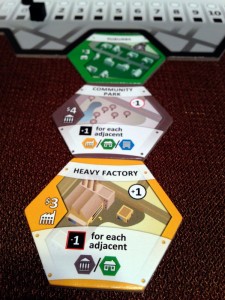
In Suburbia, your main goal is to build up your borough as efficiently as possible. Each turn, you will be buying a tile from the real estate market and placing it anywhere in your borough. What you buy matters as much as where you place it as each tile can affect many other ones in the game, possibly creating some powerful combos. As you build up your borough, you will gain both income and reputation. These will aid you with more money to buy future tiles or more people (victory points) for your borough. Be careful though, as your borough grows, so do the costs to maintain it. Expand too quickly and you will be struggling to keep up with your new found demand. The game ends somewhat randomly once players get near the end of the third stack of building tiles. At that point, players collect any bonuses for achieved goals and the player with the most population is the winner.
Components:
With a tile laying game, I didn’t have very high expectations for the components in the game. Most of the time you get some well illustrated tiles and maybe a wooden token or two. For the most part, that’s what you get in Suburbia. However, there are a few things included that make the game feel higher quality than your standard tile laying game.
First, the art and design is really well done in Suburbia. Each tile has a lot of information to show and the layout makes it really easy to know what to do when each tile is placed. With the clever use of colors and symbols players can easily decipher what each tile does and which it affects. I also found the artwork to be colorful and thematic, which was a nice touch.
Suburbia also comes with a few main boards and a dual sided player board. The two sides was a nice touch because it allows players to either build their borough going down or going up towards the center. This may be helpful for gamers with spacial limitations.
Finally, I really like the start player token, a little wooden skyscraper. It doesn’t have any function during the game other then to mark who got the first turn, but It’s very thematic and Bezier Games went the extra mile by making it a wood piece instead of a cardboard token. Great job on the components all around.
How to Play:
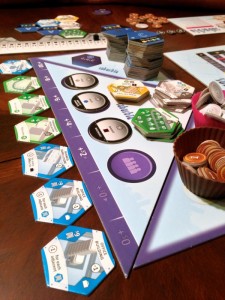
Once the game is setup, the first thing each player has to do is choose a goal. There will be a number of public goals (based on the amount of players) and each player will get a private goal (a choice from 2 random draws). The goals are just what they sound like. If a player achieves them during the game (either the public or private) they get a sizable population bonus. I do like that the titles are thematically named as well. For example, the Aquatic Engineer goal is awarded to the player with the most lakes or the Miscreant goal is awarded to the player with the worst reputation. Once the game is setup, the start player takes their turn.
Each turn has 4 parts:
1. Take and place one tile or investment marker: A player can buy any tile showing face up in the real estate market by playing the cost on the tile. There are always 7 tiles to choose from with the two rightmost tiles only costing their face value. If a player wants one of the other tiles, they have to pay extra based on its position in line. Players can also take a lake tile at no cost, which can providing a quick, one time infusion of cash. Once a player purchases a tile, they can place it anywhere in their borough. A this point the make any adjustments (see below) based on the new tile. Instead of buying a tile, a player can instead invest in one of his current tiles. The investment markers double all numbers on the tile it’s placed on and a player only has 3 to use during the game.
2. Collect Income: Players collect (or lose) income based on their position on their income track
3. Adjust population: Players gain (or lose) population based on their position on their reputation track.
4. Add a new tile to the real estate market: Players slide all tiles to the right to fill the empty space and draw a new tile. This tile is placed to the left of the existing tiles.
As mentioned before, the on other thing a player has to do on his turn is make any adjustments necessary when placing a tile. Some tiles might give players an immediate adjustment, such immediately increasing his income by 1. After a player check for immediate bonuses, he then checks each adjacent tile for any changes, followed by any other tile in his borough and lastly any other players tiles that might be affect. The game actually comes with a nice flow chart to help new player understand what they need to look for when placing a tile.
The game ends when the “one more round” tile is drawn from the real estate market. After that, each player gets another turn and the game ends. Players then check to see who scored any goals and adjust population accordingly. The player with the most population is the winner.

Game Experience:
At its core, Suburbia is all about the “economic snowball”. Players start with 3 basic tiles and are tasked with creating a bustling borough in the city. The best way to do that is by smart tile drafting and utilizing many of the games combos. Players will be buying a lot of tiles during the game and as each new tile is drawn into the building market, you can see each player slowly calculating if it will help them or not. The right tile and the right moment can do wonders for a player. Deciding which building to take from the market makes for some really hard choices in the game. Sometimes there might be 3 tiles in the building market that will help you out and you have to decide which one to take on your turn. Then you must wait and hope that the other tiles will be there as your fellow players make their choices. Sometimes though the gods of Suburbia will smile upon you and you’ll get that tile you really need and work out a great combo.
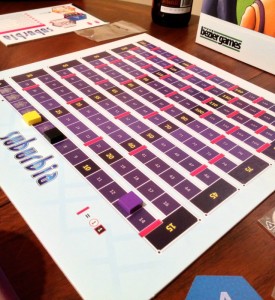
And combos there will be plenty of. Bezier Games has done a great job of making the tiles highly interactive. Each tile you build in your borough has the potential of interacting not just with your other tiles, but your opponents as well. This can create some fantastic combos during the game, especially later in the game when everyone has many different tiles in play. One of the interesting thing about the tile interaction is how well it ties to the theme of the game. Build that landfill next to a residential area and you’ll lose some reputation. Build a casino and your income will go up, but your reputation will suffer. Why yes, that slaughterhouse does give you +1 income for every restaurant anyone builds. All of this makes logical sense from a thematic perspective.
Speaking of the different tiles, I should also note that you only play with about half to two-thirds of the tiles in any given game. This adds a ton of replay value to Suburbia as you never know what tiles will be making an appearance. I have played a few games hoping to see one of my favorite tiles, only to have it not even be in the game! This forces players to keep their strategies flexible and adapt to new changes in the building market. That alone should help keep Suburbia from getting stale.
One of the interesting things about Suburbia is the way population (victory points) is handled. Whoever has the most, wins. So getting more people is great at the end of the game. However, nestled into the population track are these horrible little red lines. Each time a player crosses one of those lines due to a population gain, they lose both an income and reputation point. That’s right, as your cozy little borough gets larger, it becomes not so cozy anymore (hence the reputation drop) and costs more to maintain (hence the income drop). While I hate those red lines as a player, I think it’s a fantastic design choice as far as game mechanics are concerned. It prevents early leaders from running away with the game and forces players to be careful about which tile they choose and when. It’s a nice check and balance to make sure players don’t expand too quickly and to allow players not in first to have a chance to catch up.
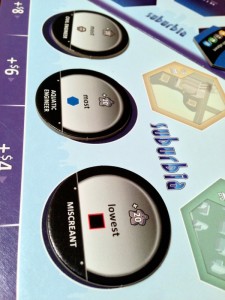
Speaking of catching up, one of the things I think could have been done better are the goals. I think they went a little overboard with the population bonus from achieving them. I have seen some wild swings at the end of the game where one player has a healthy lead only to lose by a player gaining 40 points from completing 2 goals. I do like the goals (and how cleverly named they are), I just wish the bonus points were dialed back a little. Although one of the nice things about the goals is they help foster some player interaction by creating competition for the face up goals. I’m always aware of what those goals are and where I am in position to claim them. I’ve seen some games turn into a sort of arms race as two players battle over one of the goals.
But the goal points are really my only criticism with the game. I know there is an expansions in the works and I can’t wait to get my hands on it. Suburbia is a game that can easily be expanded with many more tiles. I do almost wish they’d put out a “disaster expansion” where little tornadoes and fires would rip through the city. The game already reminds me of playing Sim City, so why not added a few disasters to keep players on their toes.
And that’s part of what makes Suburbia so fun. Sure, players that enjoy drafting or optimization will already be in love with the game. But my favorite part of Suburbia is that it brings out my inner child who enjoyed designing his city in Sim City all those years ago. Planning and building your borough in Suburbia can be incredibly entertaining and a joy to do. Sometimes during the game, I find myself getting attached to my little piece of the city. I’ll see myself avoiding the factories because I don’t want the pollution in my neighborhood. The theme is something that’s incredibly accessible and something most people are probably familiar with.
Final Thoughts:
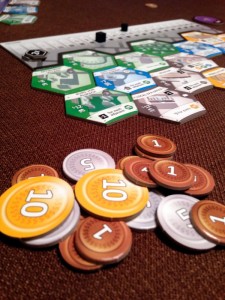
All-in-all I love Suburbia. It’s easily one of my favorite games to come out in 2012. It has streamlined game play, a decent amount of player interaction and a ton of replay value. I think Suburbia will be a hit with any eurogame fan. City building is a theme that everyone should be familiar with and the rules make the game pretty easy to pick up. Once players get a feel for how the bookkeeping works (and there is quite a bit of it), then game turns should flow pretty well. I have found that once you get up to the 4 player range, there will be a little bit more downtime, especially if you have players prone to analysis paralysis. However, it’s never been a big problem and turns should still play very fast.
But Suburbia really plays well at any player count. With 2 players you get quicker turns but less competition for any building. However at the higher player counts you get a lot more interaction between boroughs and you get to see a more diverse amount of tiles. It’s a great trade off and that helps allows Suburbia to hit the table no matter where you are at in the player count.
There aren’t very many reasons someone shouldn’t like Suburbia which makes it a must own in my book. I know they sold out of the first printing, but Suburbia is back in stock and worth checking out. Grab a copy today and start building up your little corner of the city.
If you are interested in getting a copy for yourself, it’s about $43
Final Score: 4.5 Stars – A fantastic city building game that works well at any player count. A must own.
 Hits:
Hits:
• Very thematic
• Easy to learn rules
• It fun building your city
• Minimal downtime
• Lots of replay value
Misses:
• Goals are feel a little powerful
• A lot of book keeping























Great review for a great game. The first time I played it with some friends, one of my friends told me it was the most fun he’d ever had when losing a game. And my wife, who isn’t a fanatic gamer, likes the game as well. It’s definitely a must-own as far as I’m concerned.
Good review, Tony. This game is definitely one of my faves as well. Can’t wait for the Suburbia, Inc. expansion (and the iOS version!)
Good review – I liked playing the expansion at their booth at GenCon. Can’t wait for the iPad version to be released.
Do you feel that this replaces Alhambra?
I would say that it’s a completely different game then Alhambra. Alhambra is more similar to Carcassonne in that it’s a simple tile laying game.
Suburbia is more about optimization and resource management. That being said, I think that Suburbia is a far better game than Alhambra.
Thanks.
I have Suburbia and Carcassonne already, so I guess I’m pretty well covered.